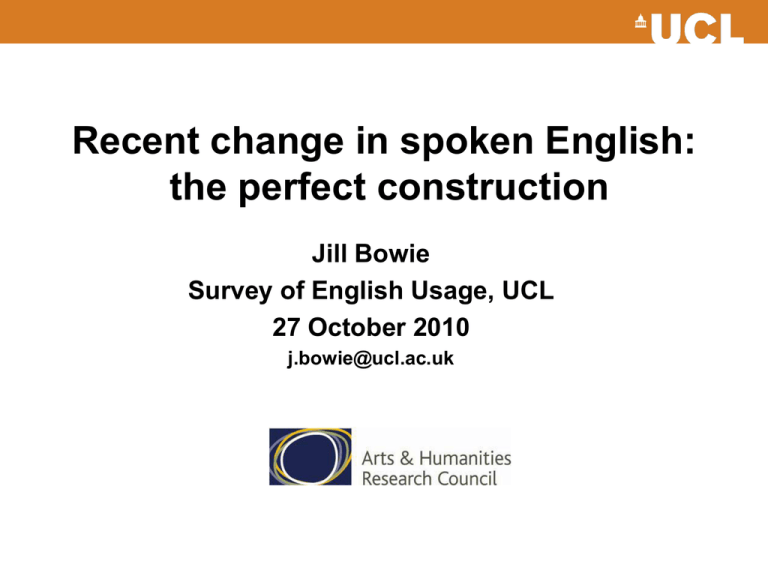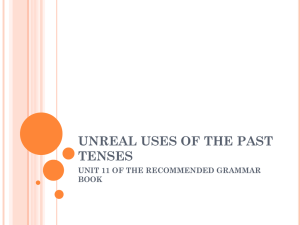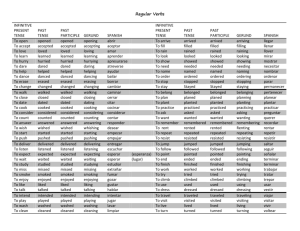Recent change in spoken English: the perfect construction Jill Bowie
advertisement

Recent change in spoken English: the perfect construction Jill Bowie Survey of English Usage, UCL 27 October 2010 j.bowie@ucl.ac.uk Plan of talk 1. Changing VP project at SEU – – Recent grammatical change as new field of study Diachronic Corpus of Present-day Spoken English 2. The English perfect construction – – What is the perfect construction? Why investigate recent change in the perfect? 3. Quantitative findings – Frequency of use: applying different methods 4. Qualitative discussion – Alternations; explanations; issue of genre variation 5. Summary 1. Changing VP project at SEU ‘The changing verb phrase in present-day British English’ led by Prof. Bas Aarts Investigating recent grammatical change in aspects of the VP in spoken British English, including: – modal auxiliaries – modal verb phrase patterns – progressive construction Recent grammatical change • New field of research, compared with long-term change • Availability of large electronic corpora • Extensive work by Leech et al. 2009, mainly on ‘Brown quartet’ of written English corpora (1m words each, matching text categories): – BrE: LOB 1961, FLOB 1991 – AmE: Brown 1961, Frown 1992 • Need for work on spoken English – Spoken language primary – Changes likely to be found first in spoken language DCPSE: Diachronic Corpus of Present-day Spoken English • Orthographically transcribed spoken BrE • Fully parsed, with tree diagrams, searchable with dedicated ICECUP software • Approx. 400,000 words each from – the LLC (London-Lund Corpus, or ‘Survey Corpus’) – the ICE-GB corpus • Matching text categories • Allows comparison over time (similar period to Brown quartet): – LLC: samples from 1958-1977 – ICE-GB: 1990-1992 FTFs (Fuzzy Tree Fragments) A search facility provided by the ICECUP software. A single-node FTF query to find present-tense perfect auxiliaries: A matching tree structure A more complex FTF ... ... and a matching tree structure 2. The English perfect construction Perfect auxiliary HAVE + verb in past participle form. Typically expresses anteriority (pastness relative to a reference point). Subtypes according to inflectional form of HAVE: • Present perfect, e.g. I’ve never written any fiction before • Past perfect, e.g. and I was staying in this sort of bedsitter place that she’d booked up for me • Perfect infinitive, e.g. I must have told you that; the virus seems to have cleared up • ing-participial perfect, e.g. and not having heard from anybody I thought I’d better check up The present perfect More complex than expressing anteriority ... • situation occurs within (or continues through) a timespan leading up to the present • typically involves ‘current relevance’, connection to present • contrasts with morphologically marked past tense (which involves time wholly in past rather than connected to present) Examples: • He’s lost his job vs He lost his job (last year) • They’ve known him since 1983 vs *They knew him since 1983 These complexities have led to varying analyses of the perfect, e.g. in terms of aspect or (secondary) tense. Non-present perfects Semantic contrast is neutralised; can correspond to either a present perfect or a (morphologically marked) past tense. Examples to illustrate for infinitival perfect: • Tick off for me the main things that you would claim to have achieved as a government since the election [corresponds to a present perfect] • And Mr Perry [...] claimed [...] to have heard a great deal of noise from this motor-cycle as it came along followed by the bang [corresponds to past tense] Why investigate recent change in perfect? Longer-term change • grammaticalization process from origins in OE to ModE: rapid increase in frequency of present perfect, mainly at expense of past tense, up to 1600, then tailing off; from 1800 to PDE, clear fall in AmE, and some evidence of fall in BrE (Elsness 1997) • contrast with some other European languages where grammaticalization process has continued, pushing the perfect further in direction of replacing past tense, e.g. S German Reports of new uses of present perfect • e.g. narrative use, increasing use with certain temporal adjuncts Regional variation: BrE vs AmE • present perfect more frequent in BrE than AmE 3. Quantitative findings Initial research questions • Is there evidence of recent change in the overall frequency of the perfect construction in spoken British English? • Is the same pattern of change seen for the different subtypes of the perfect (present, past, and non-finite)? Data retrieval • Single-node FTF searches for category AUX with type feature ‘perf’ and tense-form features ‘pres’, ‘past’, etc. • Instances of semi-modal HAVE got to automatically excluded, e.g. a lot of work has got to be done on it • Instances of stative idiom HAVE got ‘have’ are included in the search results, e.g. he’s got two kids. These resemble the perfect in form, but differ in meaning. • In present perfect results, instances of HAVE got are numerous, and most are stative or ambiguous. Found by FTF with present perfect auxiliary followed by got, and excluded from count. Frequencies (pmw) of perfect auxiliaries 7,000 LLC 6,000 ICE-GB 5,000 4,000 3,000 2,000 1,000 0 present past infinitive -ing participle % change in pmw frequencies present past infinitive -ing participle total 20% 10% 1% 0% -11% -18% -10% -20% -30% -40% -50% -34% -30% Findings • Overall, there is a statistically significant decline in the pmw frequency of the perfect construction from LLC (1960s-70s) to ICE-GB (1990s). • The different subtypes of the perfect show different patterns over time: – The present perfect shows no significant change in pmw frequency. – The past perfect and infinitive perfect both show statistically significant declines in pmw frequency. Further questions Why the declines in past perfect and perfect infinitive? • Do these findings reflect a genuine change in the use of these forms? • Or could the speakers in the later corpus simply be talking less about past time, due to chance sampling factors? Tensed, past-marked (TPM) VPs • Tensed VPs marked for past either morphologically or with perfect, or both: – – – – Past non-perfect (morphologically marked past tense) Present perfect Past perfect Modal auxiliary + perfect infinitive (= 88% of perfect infinitives) • Excludes – Present non-perfect VPs – Non-tensed VPs (this group includes to + perfect infinitive, and -ing participle perfect) TPM VPs as proportion of all VPs 30% LLC 25% ICE-GB 20% 15% 10% 5% 0% past non-perfect present perfect past perfect modal + perfect % change as proportion of all VPs past nonperfect present perfect past perfect modal + perfect total 10% 1% 0% -11% -12% -10% -20% -30% -40% -50% -35% -27% % change as proportion of TPM VPs past non-perfect present perfect 0% 14% past perfect modal + perfect 30% 20% 10% 0% -10% -20% -30% -40% -50% -26% -18% Combined graphs for % changes past nonperfect 30% 20% 10% 0% -10% -20% -30% -40% -50% present perfect past perfect modal + perfect total Findings • The categories past perfect and modal + perfect infinitive decline significantly as a proportion of TPM VPs. • This shows that declines in past perfect and perfect infinitive are not due simply to differences in rates of reference to past time. • In addition, the category present perfect increases significantly as a proportion of TPM VPs. This contrasts with the result of no significant change found when frequencies are considered per VP or pmw. Comparison with other findings Compare with findings of Hundt & Smith 2009 for present perfect in written BrE (LOB 1960s, FLOB 1990s) • Overall pmw frequencies considerably higher in spoken data: DCPSE c.6,000 pmw; LOB/FLOB c.4,000 pmw (though there is variation among text categories). • Both studies find no significant change over time in overall pmw frequencies (DCPSE slight increase, LOB/FLOB slight decrease, but neither statistically significant). • Different results for proportion of present perfect against other past forms, over time. LOB/FLOB: stable against past tense non-perfect. DCPSE: increases against other TPM VPs, and also against past tense non-perfect alone. 4. Qualitative discussion • • • • Focus on declining perfect categories Alternations with non-perfect structures? Possible explanations for observed declines Issue of genre variation Past perfect: alternations? (1) Use to express anteriority to past ref. point (past in past): contexts where ‘optional’: e.g. clauses introduced by temporal expressions such as after, as soon as, before – I met him a lot after my father had died … – They sent one to my mother after she died or something e.g. anteriority already expressed in preceding context – Sarah had left the kitchen roll in the sitting room and Chicken had methodically shredded it – I’d phoned the day before and the doctor said it wasn’t necessary e.g. ‘before just then / before now’ contexts – Oh I hadn’t realized that; I didn’t realize that Past perfect: alternations? (2) Backshifting + past time use • Special backshifted use of past tense often occurs in context of indirect reported speech or thought: e.g. She is a doctor may be reported as He said she was a doctor even if she still is • Backshifting to past perfect can occur if ‘original version’ would have had past tense or present perfect, but this is often optional Examples • And looking back over Mrs Thatcher’s eleven years in power sixty per cent said she’d been a good Prime Minister ... (cf. ‘She was/has been a good PM’; sixty per cent said she was a good PM) • And you said you first got in touch with A S Consultants before Christmas (cf. ‘I first got in touch’; you said you had first got in touch) Past perfect: alternations? (3) ‘Remoteness from reality’ + past time use • Special ‘remoteness from reality’ use of past tense occurs in contexts such as complement of WISH (I wish he was here now) or remote conditional clauses (If he came tomorrow, he could help us) • Past perfect generally used if time reference is past – I wish he had come round yesterday – it would’ve been nice if I had known Examples where past non-perfect used instead: • You’re sitting, waiting, wishing you left your house earlier. Why not use this spare time to sharpen your mind with More Brain Training on Nintendo DS? ... [advert on tube train] • I was bored. Well I would have been if I did the last year. [i.e. of study in a particular subject; cf. Gorrell 1995, examples from AmE] Possible explanations for declines of past and infinitival perfect • American influence? – Elsness 1997: AmE lower frequencies than BrE – Gorrell 1995 suggests further decline in use of past perfect in AmE • Contrast with present perfect (not declining): lowerfrequency categories more likely to suffer loss? • Increasing tendency to simplify verb phrase? – But note this is not general to all auxiliary types, cf. increasing frequency of progressive (e.g. Aarts, Close & Wallis 2010) – There may be counteracting tendencies in particular contexts, e.g. ‘double perfect’ in ‘remoteness from reality’ contexts (e.g. if-clauses in remote conditionals) ‘Double perfect’ Often considered non-standard, but common in modern speech; found since 15th century (Denison 1998) • Though I think if you’d have asked me I wouldn’t have said I did (DCPSE; only 1 e.g. in LLC & 1 in ICE-GB, both with ‘d) • What, if the comedians had have been an hour late, would you have booked another comedian? (BNC) • If more would have gone back then the strike would have come to an end quicker (BNC) Frequent association of perfect infinitive with ‘unreal’ meaning; parallelism between subordinate and main clause of conditional (Denison 1998) This context: variation past tense, past perf., double perf. Further issue: genre variation • Spoken/written language: but much variation within each • Temporal orientation varies considerably among genres • Studies show frequency/proportion of present perfect varies considerably by genre – e.g. in LOB & FLOB pmw frequency varied considerably among press (highest), in fiction (lowest), general prose, & learned (Hundt &Smith 2009) • Patterns of change over time may also vary by genre • Genre variation & perfect in DCPSE: may be best approached by considering as proportions of TPM VPs 5. Summary • English perfect as study of recent grammatical change • Different patterns of change for subtypes of perfect: past & infinitival perfect decline, present perfect increases as proportion of TPM VPs • Different methods can give different results on frequency of use (pmw, per VP, proportion of TPM VPs) • Aim to identify alternations (further quantitative testing) • Possible explanations for decline of past and infinitive perfect, e.g. increasing tendency to simplify VP • Further issue of genre variation • Much more to be explored! References and websites Aarts, B., J. Close & S. Wallis (2010) Recent changes in the use of the progressive construction in English. In B. Cappelle & N. Wada (eds.), Distinctions in English grammar, offered to Renaat Declerck. Kaitakusha,148–167. Denison, D. (1998) Syntax. In S. Romaine (ed.), The Cambridge history of the English language IV. Cambridge University Press, 92 – 329. Elsness, J. (1997) The perfect and the preterite in contemporary and earlier English (Topics in English Linguistics, 21). Mouton de Gruyter. Gorrell, R. (1995) The future of past tenses. English Today 44 (v.11 no.4), 25–27. Hundt, M., & N. Smith (2009) The present perfect in British and American English: has there been any change, recently? ICAME Journal 33, 45–63. Leech, G., M. Hundt, C. Mair, & N. Smith (2009) Change in contemporary English: a grammatical study. Cambridge University Press. Websites: Survey of English Usage (& DCPSE): www.ucl.ac.uk/english-usage BNC: http://www.natcorp.ox.ac.uk/ or http://corpus.byu.edu/bnc/ Acknowledgements This research was carried out as part of the project ‘The changing verb phrase in present-day British English’ • Led by Prof. Bas Aarts at the Survey of English Usage • Funded by the Arts & Humanities Research Council Thanks to Sean Wallis (Senior Research Fellow, SEU) for assistance with statistical analyses and discussion of methodological issues.






